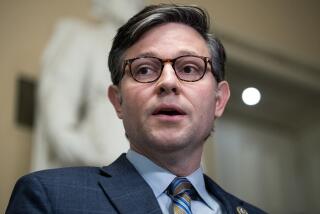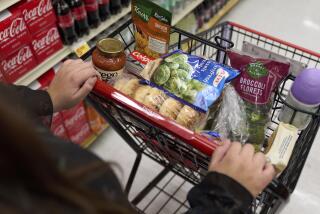POVERTY / UNCERTAIN MEASURE : Government’s Statistics on Poor No Longer Add Up, Some Claim : A formula devised in the 1960s was based on food costs. But now critics say that method leads to an undercount.
- Share via
WASHINGTON — In 1965, Molly Orshansky, a Social Security Administration researcher, vaulted into the history books by separating America’s haves from its have-nots.
The average American family of that day spent about one-third of its income on food. So, figured Orshansky, a household could escape poverty if it earned an annual income at least three times the value of the barest quantity of food its members needed to meet daily nutritional standards.
Today, the government still uses her mathematical formula to set the official poverty threshold every year.
Based on the latest calculation, the U.S. Census Bureau recently reported that about 32 million people, or 12.8% of the population, live in poverty.
To some advocates for the poor, social service administrators and government officials, the current figures are wrong.
Many more Americans actually live in poverty, they say, arguing that the methodology Orshansky developed more than a quarter century ago overlooks a large number of people who should be counted among the poor today.
PROPOSAL: “It is time to update our official poverty measure to provide a more accurate reflection of today’s economic needs,” said Rep. Lee H. Hamilton (D-Ind.), chairman of the Joint Economic Committee of Congress.
Hamilton said the old poverty formula fails to address contemporary economic realities. For example, he noted, housing costs consume far more of the typical household budget than during the mid-’60s, not to mention child care, fuel and other expenses not reflected in the official calculation.
The President’s Council of Economic Advisers is studying poverty measurement, but so far has made no recommendations.
The Census Bureau has conducted an ongoing test to measure the impact that non-cash payments and benefits--such as food stamps, housing assistance, Medicare and Medicaid--have on national poverty levels.
Dan Weinberg, chief of the Census Bureau’s housing and household economic statistics division, said that calculations based on alternate income figures did not radically shift the poverty line. Instead, he said, the figures “merely vary the amount of income compared to (poverty) threshold.”
GOAL: Pat Rugles, a Joint Economic Committee researcher and author of “Drawing the Line: Alternative Poverty Measures and their Implication,” said an ideal study would reflect changes in U.S. living standards. She suggested that government officials should set the poverty line by assigning a dollar value to a revised basket of goods and services deemed essential to the way Americans currently live.
While the committee has lacked the resources to conduct such a study, Rugles’ book outlines other changes that government officials could consider in adjusting poverty measures.
The first would involve a new standard reflecting the fact that Americans on average now spend only about one-sixth of their income on food, compared to one-third in Orshansky’s day. Setting the poverty line at six times minimum food expenditures would increase the official number of poor people to about 20% of the population. Another alternative proposed by Rugles would abandon food expenditures as the poverty standard and substitute housing costs, using 30% of income as the threshold. That calculation would increase the number of Americans in poverty to about one-fourth of the population.
But changing the poverty measures involve more than simply finding and applying a new formula. Political considerations present an even greater challenge.
IMPACT: If the standards are changed to include modern living costs, nearly all concerned agree that poverty would embrace a larger share of Americans. And that would increase pressure on the government to do more to help people escape “official poverty,” said Rugles.
Indeed, contemporary policy-makers are chary of repeating the lesson learned from Orshansky’s original work: Her discovery that some 34.6% of the nation failed to earn a poverty wage of $3,100 in 1964 triggered such sympathy for the poor and outrage at the government that costly federal programs were initiated to ease the problem.
By and large, policy-makers are willing to overlook the deficiencies of current poverty measures because they do not want to assume responsibility for assisting a larger number of poor people, Rugles said.
“By drawing attention to the poverty problems now, the potential to do something about them becomes obvious,” she said. “It’s too difficult politically to do anything about it under the current economic conditions.”
More to Read
Sign up for Essential California
The most important California stories and recommendations in your inbox every morning.
You may occasionally receive promotional content from the Los Angeles Times.













